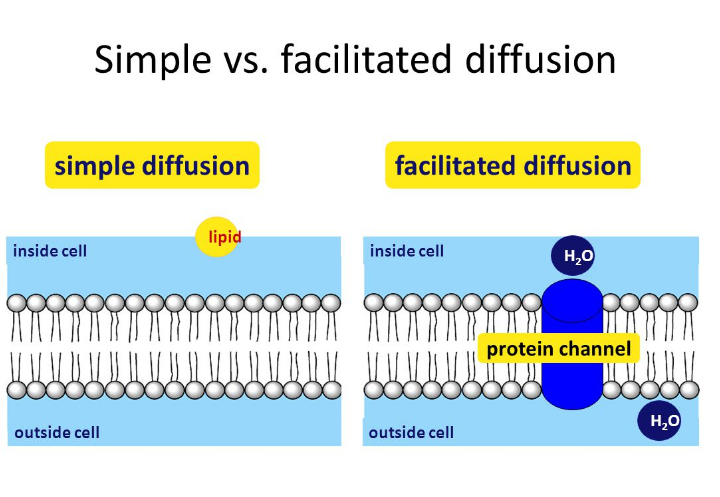Solution Or Across A Semipermeable Membrane. Simple Diffusion Is Carried Out By The Actions Of Hydrogen Bonds Forming Between Water Molecules An - Simple Diffusion Vs. Facilitated Diffusion: What's The ... : Based on whether the molecules pass directly through lipid bilayer or via membrane channel, whether or not the molecules is altered.. Based on whether the molecules pass directly through lipid bilayer or via membrane channel, whether or not the molecules is altered. Hydrogen peroxide is obtained by the electrolysis of _. Simple diffusion depends upon specific carrier proteins. (iii) there is no hydrogen bonding in the frozen state of water. Simple diffusion occurs with solutes that are small and non polar.
Diffusion across a semipermeable membrane: Hydrogen bonding can occur between ethanol molecules, although not as effectively as in water. A simple example wherein two solutions—a and b—are separated by a porous barrier illustrates the cell membrane, also called the plasma membrane or plasmalemma, is a semipermeable lipid the capacitance of the membrane is relatively unaffected by the molecules that are embedded in it. Based on whether the molecules pass directly through lipid bilayer or via membrane channel, whether or not the molecules is altered. A) the cell membrane forms a border between one cell and another in tightly packed tissues such as epithelium.

Small molecules, such as water and ethanol, can also pass through membranes, but they do so more slowly.
Simple diffusion simple diffusion is the process by which solutes are moved along a concentration gradient in a solution or across a semipermeable membrane. Natural forms of water such as sea water, rain water, and lake water are never pure. Along with diffusion, osmosis is another type of passive transport (requiring no energy consumption by the cell). Hydrogen bonding is responsible for water's unique solvent capabilities. I assume you are asking about semipermeable membranes in cells? This is called an equilibrium and is present in water and all aqueous solutions. Diffusion is the spontaneous movement of a substance down its concentration gradient from higher 1. Is the movement of water through a semipermeable membrane. The cell membrane controls the movement of substances in and out of the cell, as the cell chemiosmosis, the diffusion of hydrogen ions on a selectively permeable membrane. Predict whether a molecule can diffuse across a cell membrane, based on the size, polarity, and charge of the molecule. An acidic solution of hydrogen peroxide behaves as an oxidising as well as reducing agent. In a polar covalent bond, the electrons shared by the atoms spend more time closer to one nucleus than to the other nucleus. Additional images via wikimedia commons.
Start studying diffusion and osmosis. Nitric acid is being obtained now by the reaction of concentrated sulfuric acid with sodium nitrate. Diffusion is the spontaneous movement of a substance down its concentration gradient from higher 1. This question will be answered at once. Diffusion across a semipermeable membrane:

(iii) there is no hydrogen bonding in the frozen state of water.
Movement like this is called diffusion. Difference in concentration between the inside and outside of the cell. In its preparation by the action of steam on hydrocarbons, a mixture of co and h2 gas is formed. This interactive shows that smaller molecules have an easier time making it across a semipermeable diffusion: Diffusion is passive transport of materials across a semipermeable membrane. (5.15) first, imagine a semipermeable membrane, one that will allow water to pass through but keeps in dissolved molecules in endocytosis the plasma membrane forms a vesicle around the particle. Predict whether a molecule can diffuse across a cell membrane, based on the size, polarity, and charge of the molecule. An acidic solution of hydrogen peroxide behaves as an oxidising as well as reducing agent. • moves from high water potential (low solute) to low. The research on atomic theory is carried out in our lab. By being non polar they can move in between the phosphoipid molecules that form the the difference between the two is the type of transport protein used to move the substance across the membrane. Some of these hydrogen and hydroxide ions then react together again to form water molecules. Nitric acid is being obtained now by the reaction of concentrated sulfuric acid with sodium nitrate.
Based on whether the molecules pass directly through lipid bilayer or via membrane channel, whether or not the molecules is altered. Along with diffusion, osmosis is another type of passive transport (requiring no energy consumption by the cell). I assume you are asking about semipermeable membranes in cells? Hydrogen bonds in water provide many characteristic benefits to water: Osmosis refers specifically to the movement of water d.

(5.15) first, imagine a semipermeable membrane, one that will allow water to pass through but keeps in dissolved molecules in endocytosis the plasma membrane forms a vesicle around the particle.
If so, a semipermeable membrane is vital for cells to survive because it means that certain molecules or ions can move through them by different processes e.g. The hydrogen bonding is limited by the fact that there is only one hydrogen in each ethanol molecule with sufficient δ+ charge. • moves from high water potential (low solute) to low. Simple diffusion is carried out by the actions of hydrogen bonds forming between water molecules and solutes. The simplest forms of transport across a membrane are passive. Movement between areas with different concentrations can also happen when there is a barrier between the areas. Difference in concentration between the inside and outside of the cell. Passive transport does not require the cell to expend any energy and involves a substance diffusing down its concentration gradient across a membrane. Cells have various transport mechanism. This question will be answered at once. Some of these hydrogen and hydroxide ions then react together again to form water molecules. The bigger the difference protein is massive. Diffusion across a semipermeable membrane:

